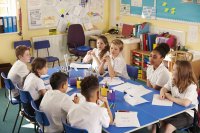An Enrichment Program for All Students
Building the remediation some students need into elective enrichment classes can be a way to open those classes to all students.
Your content has been saved!
Go to My Saved Content.Who gets the coveted seats in enrichment classes? In many schools, it’s the students who are academic stars or labeled as gifted. That’s the model my school followed for many years—academically proficient students were selected for classes such as math and word mastery competitions.
But then we reframed the question: Who deserves those seats in enrichment classes, and what enrichment classes should we be providing? Our philosophy evolved, and a program that had been an extension of academic classes evolved into one designed for all students that tapped into a wider range of interests.
Roots of Change
Several years ago, our academic intervention teachers took on the additional role of teaching students identified as needing enrichment in grades 3 to 5. Teaching two groups of children on opposite ends of the academic spectrum was an important learning experience for my colleagues and me.
We knew that the remediation we provided was an invaluable way for some students to strengthen their skills and that, in many cases, it was mandated by state regulations. We regularly collected lots of observational notes and data on each student.
At no time did our observations or data show that students who were receiving remediation would not also benefit from enrichment classes. As we thought about these two groups of children, we could not say that one group was more worthy of enrichment than the other. Could enrichment, in fact, provide the motivation and engagement that many of our students who were receiving remediation needed?
Planning and Logistics
We considered how to provide remediation and add an enrichment class each week without lengthening the school day or cutting services. Fortunately, we have one period a day called core extension, during which no new classroom instruction takes place—instead students travel to remediation, enrichment, instrument lessons, or English for speakers of other languages (ESOL) instruction.
Since academic support teachers were also teaching many of the enrichment classes, we realized that we didn’t need to add time or cut services. We just needed to provide the remediation within the enrichment classes. We could help students decode just as effectively using a text on building a computer as we could with leveled fiction. We could emphasize the importance of math conversions as students learned that computer-aided design is created in millimeters.
Students would still receive standard interventions on other days, but on enrichment days, real-life applications could provide context and motivation.
Choice and Challenge
Each semester, students choose their enrichment class—we have options in the sciences, technology, and the arts. In Fibonacci Art they can create a mathematical spiral or a board game; they do nighttime stargazing in Space Class; and they fully construct and program their own creations in Gizmos and Gadgets.
They get to decide for themselves whether they want to build a computer in one class or tap into their musical talent in another—there are up to 12 choices per semester, spanning many interests.
We carefully considered parameters that included, at every level, challenge. We were committed to including all students, and just as committed to providing a range of challenging experiences.
The art teacher would include a writing component in her classes, and the librarian’s coding class would end in reflective practice. The garden would be expanded to teach environmental stewardship. Highly motivated students would be encouraged to peer tutor and lead their own research.
Tapping into multiple interests across disciplines while maintaining a high level of challenge stayed central to our focus. In the first two years of the program, we continued to include those math and word competition classes, but today students have a greater choice, and each semester they can challenge themselves in new ways.
Inclusive and Supportive Practice
Over the last five years, we’ve offered dozens of different classes through our school-wide enrichment program. They’ve been developed through teachers’ interests and newly discovered passions. Children delighted in Skyping with the Intrepid Sea, Air, and Space Museum in Space Class and a wind-and-solar farm in Energy Class. They’ve also hosted professional scientists and engineers at the school.
A grassroots program that started as a conversation among a few teachers has developed into a full, rich program. Teachers and students have learned together, not only about the skills needed to build a computer or create a mural but about the value of choice and inclusivity. They have learned to respect and admire each other’s previously hidden talents.
We have the data to show the positive impact of the program on student growth. But just as important are the little moments we’ve witnessed that showed what we had hoped to see: a boy with an IEP showing his high-achieving classmates how to build a wind turbine, stargazers with different primary languages looking to the sky in awe, and children learning from each other through hands-on discovery.
Fluctuations in funding and staff have changed the program from year to year. Still, the core of the program remains the same: choice, rigor, and inclusion through enrichment for all, not just the few.
